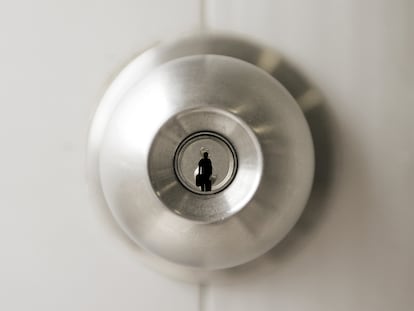How psychologists cope with anxiety: From writing down thoughts to taking a shower
Six professionals explain the strategies they use to nurture their mental health when stressing thoughts set it

Most people suffer from anxiety at some point in their lives. This feeling of dread might take the shape of sweating, palpitations or shortness of breath. Although these symptoms are a normal reaction to stress, they can also be overwhelming. EL PAÍS has contacted six psychologists to find out what they do to cope with anxiety and generally nurture their mental health.
Vanesa Fernández, PhD in psychology and professor at Complutense University in Madrid
As Vanesa Fernández, member of Madrid’s Official College of Psychology (COP), explains, “anxiety is a normal emotion that appears when we feel threatened. We all have anxiety, even psychologists,” she says. When she feels anxious, she finds it hard to concentrate as her mind is hijacked by apprehension: “I think ‘what if this happens to me now, what if that happens…” She says she also feels tense and restless, and finds it hard to sleep; sometimes she bites her nails.
To manage her anxiety, she tries to control her thoughts and focus on the here and now: “What happened has already happened and I can’t do anything about it, so I’m going to try to work out what I can do to fix it,” she says. “And if what I’m anxious about is the future, I try to focus on the fact that it hasn’t happened yet and, therefore, I don’t have to live it as such. I tell myself that right now the anxiety has no basis and I bring myself back to the present.” She also tries to share her feelings with people she loves, go to bed earlier, rest, do abdominal breathing, eat well, be physically active and eliminate stimulants such as caffeine from her diet.
Mari Zafra, psychologist, psychotherapist and CEO of Psikigai
For Mari Zafra, anxiety is necessary as it sends a signal that “there is something you’re not happy with” in your life: “A boss who disrespects you, an activity you do that you don’t really feel like doing or a couples dynamic that doesn’t make you happy,” she explains. She is convinced that physical sensations must be given space, even if they are unpleasant. Therefore, instead of running away from anxiety, she tries to “listen to it.”
Sometimes she writes her thoughts on post-it notes and sticks them on a wall to distinguish between what she is thinking and what she feels in her body. A mindfulness practice that works well for her is to close her eyes and focus on her breathing. “When you do that, thoughts come up; it’s normal and you shouldn’t try to push them out. That would be like fighting against our heartbeat,” she says.
Sometimes she focuses on what’s going on around her. She takes note of sounds and smells. “The goal is to anchor ourselves in the present so that our thoughts stop feeling like a punch in the stomach,” she explains. She then focuses on the physical sensation that causes her anxiety and asks herself questions, such as: “Where do you feel it? Could you give it a shape and color? If it were an object, what would it be – can you imagine moving it?” These practices focus on realizing that “it’s okay to feel anxiety. It doesn’t control you,” she says. Letting go of the fear of feeling a particular sensation by exposing oneself to it “ends up making it go away or making it more and more useful and adaptive.”
Adrián Gimeno, psychologist and psychotherapist specializing in eating disorders
When Adrián Gimeno has anxiety, he tries to take a shower and focus on his breathing. Or he leaves whatever task is making him anxious and writes down what he is thinking and feeling so he can read it again when he is calmer. These strategies don’t always work for him “but there is no exact formula that is infallible. You have to make adjustments according to what is going on and what you need,” he says.
If there is one thing that does help him feel better, it is speaking to someone he trusts: “It helps me to gain perspective,” he says. He also finds it can be helpful to answer these questions in writing: “What am I afraid of? Can I do anything about it right now? What do I need now to reassure myself?” If the situation happens again and somehow limits daily life, “the best approach is to go to a professional therapist who can help us understand and manage the anxiety.”
Claudia Pradas Gallardo, psychology professional
Claudia Pradas used to find it very difficult to detect anxiety before it reached a certain pitch when it “could even trigger certain anxiety crises.” Now, as soon as she realizes that her stress and anxiety levels are escalating, she tries to get “safe: Stop what I’m doing, even if my head tells me it’s very important and, once I’m safe from my thoughts, I try to do relaxation exercises.”
But when she’s really anxious, meditation doesn’t work well for her. “It’s like forcing myself not to think about anything and, of course, I then feel it as a categorical imperative,” says Pradas, who has written the book Todo saldrá (bien) (Everything will work out (fine)). Instead, she tries to distract herself by taking a walk, watching TikTok videos for five or 10 minutes or being with her cat. Once the anxiety subsides slightly, she says she feels strong enough to restructure her thoughts. She also considers it essential to practice self-compassion: “Having a kind discourse with oneself is super important,” she says.
Beatriz Belmonte, psychologist, sexologist and couple’s therapist
Beatriz Belmonte is clear about what makes her feel better and what doesn’t when she’s anxious. “Staying at home all day doesn’t help me at all, as it doesn’t allow me to put a brake on my thoughts and this exacerbates the anxiety,” she says. What does help, in her case, is to recognize the anxiety and give it space, as well as trying to disconnect and take care of herself.
Among the tools she uses to distract herself are going for a walk, cooking, calling friends and family or meeting up with them, listening to music or dancing, painting mandalas, reading a chapter of a good book, watching a series or a movie, going to the gym, taking a shower or preparing a meal she likes. She also practices techniques such as Jacobson’s progressive relaxation technique or diaphragmatic breathing, which consists of breathing in slowly through the nose and then breathing out through the mouth using the diaphragm and abdominal muscles.
Although these strategies often work for her, she doesn’t always manage to disconnect or feel the way she would like to. “It’s important to understand this too, because otherwise we can become frustrated or resigned. There are days when I simply understand that I have to get through the ‘storm’ and that nothing is going to help me as much as I would like,” she says. In her day-to-day life, Belmonte tries to avoid functioning on autopilot and, instead, spends a few minutes every day asking herself how she feels and what she needs: “The body is constantly sending us signals, but if we don’t stop and observe them, we can’t address them.”
Jesús Linares Martín, emergency health psychologist
“When I have anxiety, the first thing I do is identify it and then see what it wants to tell me,” says Jesús Linares Martín, director of the master’s degree in psychological intervention in crises, catastrophes and emergencies at the European University and member of Madrid’s Official College of Psychology (COP). “I try to pinpoint what it is related to or what ‘threat’ it is warning me about.” Afterwards, I try to get things in perspective and use strategies focused on the unpleasant emotion I’m feeling or on the problem in hand.
The psychologist insists that doing physical and enjoyable activities on a daily basis helps to lower anxiety levels and to feel a general satisfaction with life. Among the little things that help to keep his anxiety at bay include a walk with his dog, a video call with family or friends outside Madrid, cooking while listening to music, arranging plants, going out with his partner to the movies or dinner, writing, drawing and restoring furniture.
Sign up for our weekly newsletter to get more English-language news coverage from EL PAÍS USA Edition
Tu suscripción se está usando en otro dispositivo
¿Quieres añadir otro usuario a tu suscripción?
Si continúas leyendo en este dispositivo, no se podrá leer en el otro.
FlechaTu suscripción se está usando en otro dispositivo y solo puedes acceder a EL PAÍS desde un dispositivo a la vez.
Si quieres compartir tu cuenta, cambia tu suscripción a la modalidad Premium, así podrás añadir otro usuario. Cada uno accederá con su propia cuenta de email, lo que os permitirá personalizar vuestra experiencia en EL PAÍS.
¿Tienes una suscripción de empresa? Accede aquí para contratar más cuentas.
En el caso de no saber quién está usando tu cuenta, te recomendamos cambiar tu contraseña aquí.
Si decides continuar compartiendo tu cuenta, este mensaje se mostrará en tu dispositivo y en el de la otra persona que está usando tu cuenta de forma indefinida, afectando a tu experiencia de lectura. Puedes consultar aquí los términos y condiciones de la suscripción digital.
More information
Últimas noticias
Most viewed
- Reinhard Genzel, Nobel laureate in physics: ‘One-minute videos will never give you the truth’
- Oona Chaplin: ‘I told James Cameron that I was living in a treehouse and starting a permaculture project with a friend’
- Pablo Escobar’s hippos: A serious environmental problem, 40 years on
- Charles Dubouloz, mountaineering star, retires at 36 with a farewell tour inspired by Walter Bonatti
- Why we lost the habit of sleeping in two segments and how that changed our sense of time











































